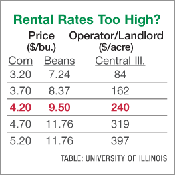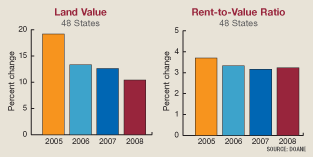Moneywise

Wish for a longer runway![]()
Agriculture producers could have used a longer runway to be able to coast into this economic downturn. But with crop prices plummeting recently and concerns about credit availability and costs, the landing appears to be more of a tailhook stop on an aircraft carrier than a greaser on a milelong runway. However, you can position your operation to be safe and profitable by adopting the following methods:
1. Don't let worries get you down. Bret Oelke, Extension ag business management specialist at the University of Minnesota, says that "farmers are getting nervous.” He advises: "Don't worry about the things that you can't change, worry about the things you can. Plan for marketing, manage costs of production and position your operation for opportunities that will present themselves in times of turmoil.”
2. Be willing to sell at a profit. Allen Lash of AgriSolutions in Brighton, Ill., says farmers can increase their profit by selling production at higher prices. "We had the opportunity to sell corn at $7/bu., but how many did?” Know with certainty your own costs and define an acceptable profit level. Sell at least some at that level.
3. Bulletproof your balance sheet. Greg Wolf, an agriculture consultant for Kennedy and Coe in Pratt, Kan., says this means strengthening both your net worth and working capital to create strength and flexibility. Ask yourself: "Do I understand the risk exposure of my balance sheet? If my banking relationship were threatened for any reason, how bankable am I?”
4. Boost working capital. Many lenders now require working capital equal to 20% of revenue, up from 15%, Lash says. That may mean putting off buying land or equipment and paying income tax.
5. Evaluate business strategies. Ask yourself if it is "time to double down on growth for the next generation, to draw back with ‘profit taking' while the opportunity is available, or one of the myriad strategic responses in between,” Wolf says. Perhaps most important is keeping your eyes wide open toward business fundamentals.” —Sara Muri
Not quite borrowing as usual
In general, ag lenders are in excellent shape, two dozen CEOs of Farm Credit System (FCS) branches from across the country told me at a meeting in Philadelphia on Oct. 16. Repayment rates on loans are up strongly on record net farm income, and loans in arrears are well below the national average for all loans, they note.
However, it is not business as usual, even at FCS, which so far has been largely insulated from the credit meltdown. You'll see tighter loan requirements and more restrictions, the CEOs say. Rates will be higher and terms for some loans may be shorter.
They offer the following tips to ensure you get the credit you need:
• Visit your banker early to discuss your anticipated credit needs.
• Communicate often. "Surprises are not good,” one CEO commented.
• Bring good records. "Managerial accounting is required on some bigger deals.”
• Cash is king. Build your war chest. "Be cautious about making capital expenditures,” one CEO cautioned. "Spend money only if the purchase advances your business model.”
• Shop around/negotiate. Although this isn't the time to switch bankers on a whim, those with better balance sheets and funding prospects will be able to offer better rates, especially to star borrowers. —Linda H. Smith
Revisit cash rental rates
Given the dramatic drops in crop prices since summer, you may want to recalculate cash rent, say Gary Schnitkey and Dale Lattz of the University of Illinois. They suggest:
• Use variable cash rent or share rent. But be careful: You must split farm program payments or tie the variable rate to factors not under your control—for example, base price used to set insurance coverage; county average price and yield (see the Law & Taxation section at www.farmdoc.uiuc.edu).
• Delay setting fixed cash rental rates until March.
• Renegotiate cash rents set at high levels based on $5-plus corn and $11-plus soybeans.
"Nonland cost of production is expected to be double 2003–2007 levels,” the economists say. "At $4.20 corn and $9.50 soybeans, estimated operator and farmland returns are $240 for central Illinois high-producing land. That needs to be divided between operator and landlord [see table]. At the same time, risks have risen greatly.” —Linda H. Smith
Stress cracks in land price outlook
We've seen a three-year slide in the rate of increase in cropland values, reports Dan Manternach of Doane Advisory Services, based on USDA's annual survey. From a nearly 20% increase in 2005, we saw only a touch over 10% in 2008 nationally minus Alaska and Hawaii (see left graph below).
Rate of growth in land values in most areas dropped considerably, with only the Northern Plains showing a big upward bounce, from about 12% to 19%. "Soaring prices for spring wheat, durum, sunflower and soybeans get the credit,” Manternach says.
The Corn Belt is showing only "hairline cracks,” he adds. In fact, prices increased 14.8% this year compared with 14.5% in 2007.
The rent-to-value ratio in the Corn Belt continued to slide—to about 3.25%—though at a slower rate than the previous two years (see 48-states average, right graph below). "This key indicator could likely bottom in 2009. Either rents are going to begin rising faster than land values or rents might not rise at all and land values could soften a bit to bring the ratio back up to its long-term value in the 5% to 6% range.”
You can purchase the Doane Strategic Planning Quarterly at www.doane.com or by calling Pam Crisanti at 314-372-3520. —Linda H. Smith
What's a college kid cost?
A recent survey of agriculture interns and new graduates shows that interns in chemicals/fertilizer, seed research/development, commodities trading and cattle/swine production were paid $8 to $16/hour, reports AgCareers.com. The average hourly rate in cattle/swine production is $9.69. Over 80% of companies paid 100% of intern housing costs.
The average annual base salary for a new graduate in cattle or swine production is $32,420.
Common trends among all sectors surveyed included:
• Employee referrals and networking are the top way to recruit employees; online job boards were second.
• More than 80% of employers compensate in addition to base pay; most have budgeted salary increases of 3% to 4%.
• Fifteen percent say employee turnover rate is 8% to 10%; a quarter of participants say it is 20% to 26%.
AgCareers.com plans to do the survey annually.
Silver lining in soft economy?
Natural gas futures have fallen 50% from their highs near $13.50/MMBtu just a few months ago. After having less natural gas in storage than the five-year average from March through July, the nation's supplies have rebounded to slightly above the average. The Department of Energy's Energy Information Administration projects them remaining that way through 2009.
Natural gas accounts for 70% to 90% of production costs of ammonia. Add the fact that transportation costs have weakened, and you might expect fertilizer prices to ease. The chart below shows that urea has collapsed in recent weeks. "We've been recommending for some time that you hold off fertilizer purchases,” says Jerry Gulke of Strategic Marketing Services in Chicago. "And when you do, negotiate!” ![]()
Don't expect it to languish, however. "Fertilizer remains a profitable investment for farmers in both the U.S. and South America,” says Harry Vroomen, vice president of economic services for The Fertilizer Institute. "Fertilizers are responsible for between 40% and 60% of the world's food supply and if we are to meet rising demand for food, fertilizer is a central part of the solution.”
For a link to track world price trends, go to www.TopProducer-Online.com, Web Extra. —Linda H. Smith
One-liners
"Food is very political. When oil prices go up, we complain. When food goes up, people riot.” Mike Moran, Daiwa Securities America, New York
"Take your banker out to lunch once a month.” Dan Basse, AgResource, Chicago
"We have to be careful about crying ‘fire' in a crowded theater. But calling this a meltdown is like crying ‘fire' in an inferno.” Daniel Gross's "Money Culture” column, Oct. 6 Newsweek
"This [financial bailout] is going to unleash rampant inflation around the world. They are unleashing an inflationary holocaust.” Jim Rogers, author and commodity fund manager, on GoldSeek.com, Oct. 13.
Top Producer, November 2008







